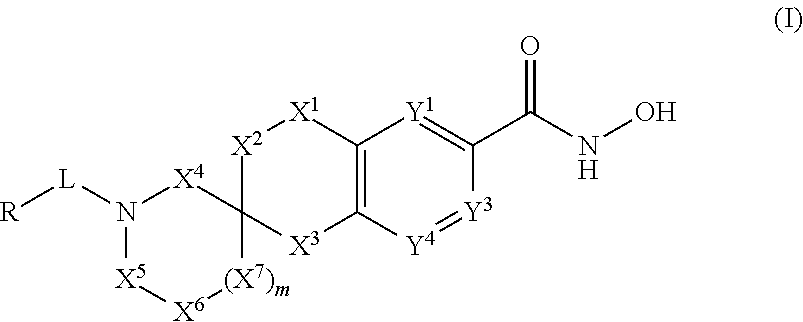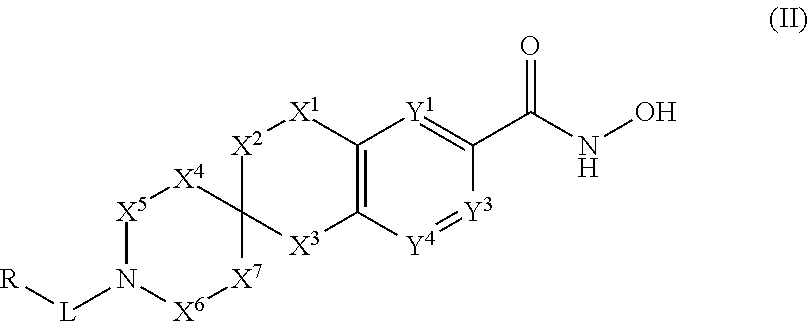3-spiro-7-hydroxamic acid tetralins as HDAC inhibitors
a technology of spiro-7-hydroxamic acid and tetralin, which is applied in the direction of nervous disorders, drug compositions, organic chemistry, etc., can solve the problems of limited effectiveness and unwanted side effects
- Summary
- Abstract
- Description
- Claims
- Application Information
AI Technical Summary
Benefits of technology
Problems solved by technology
Method used
Image
Examples
example 1
Preparation of 1′-benzyl-N-hydroxy-2′-oxo-3,4-dihydro-1H-spiro[naphthalene-2,3′-piperidine]-6-carboxamide (I-176)
[0481]
Step-1: Dimethyl 1,2,3,4-tetrahydronaphthalene-2,6-dicarboxylate
[0482]Into a 2-L pressure tank reactor was placed 2,6-dimethyl naphthalene-2,6-dicarboxylate (50 g, 204.71 mmol, 1 equiv) in isopropanol (1.2 L), palladium on carbon (9.5 g) and acetic acid (5 g, 83.26 mmol, 0.41 equiv). Hydrogen gas (50 atm) was introduced. The resulting solution was stirred for 2 days at 40° C. The solids were filtered off. The filter cake was washed with 2×200 mL of CH2Cl2 and 2×200 mL of MeOH. The combined filtrate was concentrated under vacuum. The residue was dissolved with 300 mL of EtOAc. The pH was adjusted to 8 using aq. Na2CO3. The organic layer was washed with 3×100 mL of H2O and dried with anhydrous Na2SO4, filtered and concentrated under vacuum to give 40 g (79% yield) of the title compound as a white solid. MS: (ES, m / z): 249 [M+H]+.
Step-2: Dimethyl 2-(2-cyanoethyl)-1,2,3...
example 2
Preparation of N-hydroxy-2′-oxo-3,4-dihydro-1H-spiro[naphthalene-2,3′-piperidine]-6-carboxamide (I-177)
[0487]
[0488]Into an 8-mL vial, was placed a solution of methyl 2′-oxo-3,4-dihydro-1H-spiro[naphthalene-2,3′-piperidine]-6-carboxylate (70 mg, 0.26 mmol, 1 equiv) in THF / MeOH (4:1, 1.5 mL), NH2OH (50% in water, 0.51 mL, 2 equiv) and 1N aq. NaOH (0.51 mL, 30 equiv). The resulting solution was stirred for 3 h at room temperature. The crude product was purified by Prep-HPLC with the following conditions: Column: Sunfire C18, 19×150, 5 μm; Mobile Phase A: Water / 0.05% TFA, Mobile Phase B: CH3CN / 0.05% TFA; Flow rate: 25 mL / min; Gradient: 5% B to 52% B in 6 min); Detector: UV 254 nm, 220 nm. The collected fractions were lyophilized to give 39.2 mg (56% yield) of the title compound as an off-white solid. 1H-NMR (400 MHz, DMSO-d6) δ (ppm): 11.08 (br s, 1H), 7.50-7.41 (m, 3H), 7.13-7.12 (m, 1H), 3.16-3.06 (m, 3H), 2.82-2.71 (m, 2H), 2.70-2.65 (m, 1H), 2.08-2.00 (m, 1H), 1.70-1.66 (m, 3H), 1.5...
example 3
Preparation of N-hydroxy-1′-methyl-2′-oxo-3,4-dihydro-1H-spiro[naphthalene-2,3′-piperidine]-6-carboxamide (I-178)
[0489]
Step-1: 1′-Methyl-2′-oxo-3,4-dihydro-1H-spiro[naphthalene-2,3′-piperidine]-6-carboxylic acid
[0490]Into an 8-mL vial, was placed a solution of methyl 2′-oxo-3,4-dihydro-1H-spiro[naphthalene-2,3′-piperidine]-6-carboxylate (100 mg, 0.37 mmol, 1 equiv) in DMF (4 mL). This was followed by the addition of NaH (60% dispersion in oil, 44 mg, 1.83 mmol, 3 equiv), in portions at 0° C. over 10 min. To this was added CH3I (104 mg, 0.73 mmol, 2 equiv). The resulting mixture was stirred for 18 h at room temperature. The reaction was then quenched by the addition of 10 mL of NH4Cl (aq.) at 0° C. The resulting solution was extracted with 2×20 mL of EtOAc. The aqueous layers were combined and the pH of the solution was adjusted to 4 with 1N aq. HCl. The resulting solution was extracted with 3×30 mL of CH2Cl2, dried over anhydrous magnesium sulfate, filtered and concentrated under va...
PUM
| Property | Measurement | Unit |
|---|---|---|
| temperature | aaaaa | aaaaa |
| temperature | aaaaa | aaaaa |
| temperature | aaaaa | aaaaa |
Abstract
Description
Claims
Application Information
 Login to View More
Login to View More - R&D
- Intellectual Property
- Life Sciences
- Materials
- Tech Scout
- Unparalleled Data Quality
- Higher Quality Content
- 60% Fewer Hallucinations
Browse by: Latest US Patents, China's latest patents, Technical Efficacy Thesaurus, Application Domain, Technology Topic, Popular Technical Reports.
© 2025 PatSnap. All rights reserved.Legal|Privacy policy|Modern Slavery Act Transparency Statement|Sitemap|About US| Contact US: help@patsnap.com



